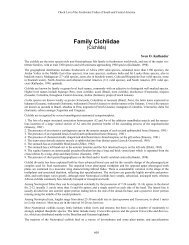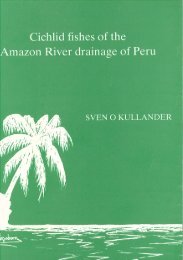Open Access PDF - Sven Kullander
Open Access PDF - Sven Kullander
Open Access PDF - Sven Kullander
Create successful ePaper yourself
Turn your PDF publications into a flip-book with our unique Google optimized e-Paper software.
322<br />
ray longest, reaching halfway to end of anal-fin<br />
base. Pelvic fin with tip formed by subequally<br />
long 1st and 2nd rays, inner branch of 1st usually<br />
slightly the longest, extending about halfway<br />
to anal-fin origin, relatively longer in juveniles.<br />
Dorsal fin from behind last spine to behind<br />
11th or 12th ray with small scales in one or two,<br />
in large specimens up to four rows close behind<br />
preceding spine or ray and in deeper ray branches.<br />
Anal fin with thick basal layer and most of fin<br />
except distal parts of posterior rays covered by<br />
scales. Caudal fin densely scaled, distal } of<br />
median portion of central membrane and, narrowly,<br />
hind margin of fin naked. Pectoral fin with<br />
small cycloid scales proximally. Pelvic-fin lateral<br />
side with dense pluriserial layer of scales between<br />
spine and second ray, extending to near fin tip;<br />
medial side with one or two rows of cycloid interradial<br />
scales between spine and first ray, first and<br />
second ray, and basally between second and third<br />
ray; dense layer of scales over base of fin; also<br />
scales between major branches of outer rays.<br />
Juveniles 45-50 mm SL similar to adults, but<br />
slenderer. Dorsal, pectoral and pelvic fins naked,<br />
almost half of caudal fin scaled, and anal fin scaled<br />
basally. Dorsal and pelvic fin squamation present<br />
from about 100 mm SL, pectoral fin scales present<br />
from 175 mm SL.<br />
Colouration in preservative. Juveniles 45-50 mm<br />
SL (Fig. 24) whitish ventrally; dorsum, occiput<br />
and dorsal part of caudal peduncle greyish, side<br />
dusky down to about level of horizontal band.<br />
Snout, preorbital, projecting part of lower jaw<br />
dark grey. Bars 1-3 dark grey, extending from<br />
back at dorsal-fin base onto abdominal side; each<br />
including black vertically extended spot on middle<br />
of side, less intense in bar 2. Wide black band<br />
from caudal spot rostrad to bar 3, and fainter to<br />
bar 2. Caudal fin smoky except white horizontally<br />
elongate spots on each side of proximal half<br />
of black band continuing band on body to hind<br />
margin of fin; band pigmentation more intense<br />
basally on fin. Anal and pelvic fins white or hyaline.<br />
Spinous dorsal fin with some dark pigment<br />
basally and along margin, but no pattern formed;<br />
horizontal dark stripe may be present along middle<br />
of soft dorsal fin.<br />
Specimens about 100 mm SL with horizontal<br />
band remaining, dark grey, from caudal blotch<br />
to bar 4 position, band absent in specimens<br />
longer than about 120 mm SL. Anal fin and dorsal<br />
part of pelvic fin greyish; spinous and soft<br />
dorsal fin blackish, with two and three series of<br />
white spots, respectively; caudal fin dark grey<br />
with indistinct light spots in dorsal lobe, generally<br />
better expressed in larger specimens; caudal<br />
ocellus fully formed, in dorsal rather than midaxial<br />
position, black nuclear part of pupil diameter,<br />
white ventrally incomplete ring of eye diameter.<br />
Specimens 100-140 mm SL may possess indistinct<br />
scattered small light spots along middle of side.<br />
Light dorsal-fin spots retained in specimens about<br />
140-150 mm SL (Fig. 25), apparently lost from<br />
spinous portion in those larger. Bar 3 may be<br />
reduced to blotch above lateral line level, with<br />
some adjacent silvery spots large specimens (<strong>Kullander</strong>,<br />
1986: pl. 3 fig. 2; 175 mm SL).<br />
Young adult 211 mm SL (<strong>Kullander</strong>, 1986: pl. 3<br />
fig. 1). Ground colour grey, light on flanks, dark<br />
Table 15. Morphometry of Cichla monoculus. Measurements are in percent of SL, except SL (in mm). Linear regression<br />
parameters calculated from original measurements in mm.<br />
N min max mean SD a b r<br />
SL (mm) 35 44.3 343.9 200.5<br />
Head length 35 31.5 35.3 33.5 0.93 0.446 0.331 0.998<br />
Snout length 35 9.2 13.0 11.3 0.79 –1.932 0.126 0.994<br />
Head depth 35 21.2 29.7 24.1 1.57 –2.292 0.255 0.988<br />
Body depth 35 27.1 34.6 30.6 1.56 –0.190 0.309 0.995<br />
Orbit diameter 35 6.8 11.3 8.5 1.05 2.477 0.069 0.984<br />
Interorbital width 35 7.7 9.9 8.8 0.58 –1.586 0.098 0.995<br />
Pectoral fin length 33 22.6 28.9 25.1 1.45 –2.221 0.265 0.992<br />
Upper jaw length 35 13.8 16.8 15.2 0.84 –2.286 0.167 0.995<br />
Lower jaw length 35 18.0 21.2 19.4 0.76 –1.128 0.201 0.995<br />
Caudal peduncle depth 35 9.9 12.6 11.1 0.58 –0.154 0.112 0.993<br />
Caudal peduncle length 35 15.2 20.2 18.3 1.05 1.461 0.174 0.989<br />
Dorsal spine length 35 11.2 16.0 13.8 1.21 3.531 0.117 0.980<br />
<strong>Kullander</strong> & Ferreira: Review of Cichla




